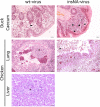Length variations in the NA stalk of an H7N1 influenza virus have opposite effects on viral excretion in chickens and ducks
- PMID: 22013034
- PMCID: PMC3255888
- DOI: 10.1128/JVI.05474-11
Length variations in the NA stalk of an H7N1 influenza virus have opposite effects on viral excretion in chickens and ducks
Abstract
A deletion of ∼20 amino acids in the stalk of neuraminidase is frequently observed upon transmission of influenza A viruses from waterfowl to domestic poultry. A pair of recombinant H7N1 viruses bearing either a short- or long-stalk neuraminidase was genetically engineered. Inoculation of the long-stalk-neuraminidase virus resulted in a higher cloacal excretion in ducks and led conversely to lower-level oropharyngeal excretion in chickens, associated with a higher-level local immune response and better survival. Therefore, a short-stalk neuraminidase is a determinant of viral adaptation and virulence in chickens but is detrimental to virus replication and shedding in ducks.
Figures




Similar articles
-
A genetically engineered waterfowl influenza virus with a deletion in the stalk of the neuraminidase has increased virulence for chickens.J Virol. 2010 Jan;84(2):940-52. doi: 10.1128/JVI.01581-09. Epub 2009 Nov 4. J Virol. 2010. PMID: 19889765 Free PMC article.
-
Deglycosylation and truncation in the neuraminidase stalk are functionally equivalent in enhancing the pathogenicity of a high pathogenicity avian influenza virus in chickens.J Virol. 2025 Mar 18;99(3):e0147824. doi: 10.1128/jvi.01478-24. Epub 2025 Feb 14. J Virol. 2025. PMID: 39950775 Free PMC article.
-
Deletion of the C-terminal ESEV domain of NS1 does not affect the replication of a low-pathogenic avian influenza virus H7N1 in ducks and chickens.J Gen Virol. 2013 Jan;94(Pt 1):50-58. doi: 10.1099/vir.0.045153-0. Epub 2012 Oct 10. J Gen Virol. 2013. PMID: 23052391
-
Prevalence of the C-terminal truncations of NS1 in avian influenza A viruses and effect on virulence and replication of a highly pathogenic H7N1 virus in chickens.Virulence. 2016 Jul 3;7(5):546-57. doi: 10.1080/21505594.2016.1159367. Epub 2016 Mar 16. Virulence. 2016. PMID: 26981790 Free PMC article.
-
H9N2 Influenza Virus Infections in Human Cells Require a Balance between Neuraminidase Sialidase Activity and Hemagglutinin Receptor Affinity.J Virol. 2020 Aug 31;94(18):e01210-20. doi: 10.1128/JVI.01210-20. Print 2020 Aug 31. J Virol. 2020. PMID: 32641475 Free PMC article.
Cited by
-
Revisiting influenza A virus life cycle from a perspective of genome balance.Virol Sin. 2023 Feb;38(1):1-8. doi: 10.1016/j.virs.2022.10.005. Epub 2022 Oct 27. Virol Sin. 2023. PMID: 36309307 Free PMC article. Review.
-
Low Pathogenicity H7N3 Avian Influenza Viruses Have Higher Within-Host Genetic Diversity Than a Closely Related High Pathogenicity H7N3 Virus in Infected Turkeys and Chickens.Viruses. 2022 Mar 8;14(3):554. doi: 10.3390/v14030554. Viruses. 2022. PMID: 35336961 Free PMC article.
-
Development of Digital Droplet PCR Targeting the Influenza H3N2 Oseltamivir-Resistant E119V Mutation and Its Performance through the Use of Reverse Genetics Mutants.Curr Issues Mol Biol. 2023 Mar 17;45(3):2521-2532. doi: 10.3390/cimb45030165. Curr Issues Mol Biol. 2023. PMID: 36975535 Free PMC article.
-
A Unique Multibasic Proteolytic Cleavage Site and Three Mutations in the HA2 Domain Confer High Virulence of H7N1 Avian Influenza Virus in Chickens.J Virol. 2015 Oct 21;90(1):400-11. doi: 10.1128/JVI.02082-15. Print 2016 Jan 1. J Virol. 2015. PMID: 26491158 Free PMC article.
-
Genetic changes that accompanied shifts of low pathogenic avian influenza viruses toward higher pathogenicity in poultry.Virulence. 2013 Aug 15;4(6):441-52. doi: 10.4161/viru.25710. Epub 2013 Jul 16. Virulence. 2013. PMID: 23863606 Free PMC article. Review.
References
-
- Baigent SJ, McCauley JW. 2001. Glycosylation of haemagglutinin and stalk-length of neuraminidase combine to regulate the growth of avian influenza viruses in tissue culture. Virus Res. 79:177–185 - PubMed
-
- Banks J, et al. 2001. Changes in the haemagglutinin and the neuraminidase genes prior to the emergence of highly pathogenic H7N1 avian influenza viruses in Italy. Arch. Virol. 146:963–973 - PubMed
-
- Campitelli L, et al. 2004. Interspecies transmission of an H7N3 influenza virus from wild birds to intensively reared domestic poultry in Italy. Virology 323:24–36 - PubMed
-
- Dundon WG, Milani A, Cattoli G, Capua I. 2006. Progressive truncation of the non-structural 1 gene of H7N1 avian influenza viruses following extensive circulation in poultry. Virus Res. 119:171–176 - PubMed
Publication types
MeSH terms
Substances
LinkOut - more resources
Full Text Sources
Other Literature Sources
Medical

